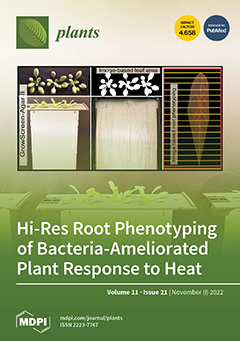Light is one of the most crucial parameters for enclosed cannabis (
Cannabis sativa) production, as it highly influences growth, secondary metabolite production, and operational costs. The objective of this study was to investigate and evaluate the impact of six light spectra
[...] Read more.
Light is one of the most crucial parameters for enclosed cannabis (
Cannabis sativa) production, as it highly influences growth, secondary metabolite production, and operational costs. The objective of this study was to investigate and evaluate the impact of six light spectra on
C. sativa (‘Babbas Erkle Cookies’ accession) growth traits and secondary metabolite (cannabinoid and terpene) profiles. The light spectra evaluated included blue (430 nm), red (630 nm), rose (430 + 630 nm, ratio 1:10), purple (430 + 630 nm, ratio 2:1), and amber (595 nm) LED treatments, in addition to a high-pressure sodium (HPS, amber-rich light) treatment as a control. All the LED light treatments had lower fresh mean inflorescence mass than the control (HPS, 133.59 g plant
−1), and monochromatic blue light yielded the least fresh inflorescence mass (76.39 g plant
−1). Measurement of Δ9-tetrahydrocannabinol (THC) concentration (%) and total yield (g plant
−1) showed how inflorescence mass and THC concentration need to be analyzed conjointly. Blue treatment resulted in the highest THC concentration (10.17% m/m), yet the lowest THC concentration per plant (1.44 g plant
−1). The highest THC concentration per plant was achieved with HPS (2.54 g plant
−1). As with THC, blue light increased cannabigerol (CBG) and terpene concentration. Conversely, blue light had a lesser impact on cannabidiol (CBD) biosynthesis in this
C. sativa chemotype. As the combined effects of the light spectrum on both growth traits and secondary metabolites have important ramifications for the industry, the inappropriate spectral design could cause a reduction in cannabinoid production (20–40%). These findings show promise in helping producers choose spectral designs that meet specific
C. sativa production goals.
Full article






